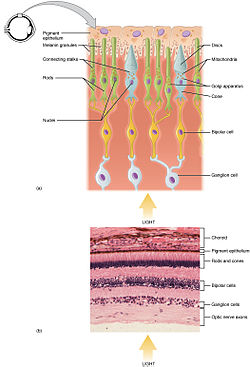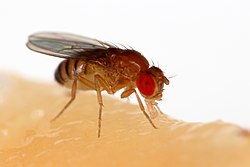Vertebrate visual opsins are a subclass of ciliary opsins and mediate vision in vertebrates. They include the opsins in human rod and cone cells. They...
10 KB (1,049 words) - 08:32, 25 March 2025
membrane (i.e. hyperpolarization.) Vertebrate visual opsins are a subclass of ciliary opsins that express in the vertebrate retina and mediate vision. They...
86 KB (9,314 words) - 23:48, 7 February 2025
Photoreceptor cell (redirect from Vertebrate photoreceptor)
apply to the phototransduction pathway from vertebrate rod/cone photoreceptors are: The Vertebrate visual opsin in the disc membrane of the outer segment...
26 KB (2,939 words) - 18:31, 17 May 2025
cells (rods and cones) in the vertebrate retina. A photon is absorbed by a retinal chromophore (each bound to an opsin), which initiates a signal cascade...
20 KB (2,366 words) - 05:14, 10 September 2024
Visible spectrum (redirect from Visual spectrum)
wavelengths that can both reach the retina and trigger visual phototransduction (excite a visual opsin). Insensitivity to UV light is generally limited by...
37 KB (4,037 words) - 23:22, 2 May 2025
one rod opsin class (rhodopsin, Rh1), all of which were inherited from early vertebrate ancestors. These five classes of vertebrate visual opsins emerged...
13 KB (1,427 words) - 19:18, 7 February 2025
Melanopsin (redirect from Opsin 4)
related to invertebrate visual opsins, which are rhabdomeric opsin, than to vertebrate visual opsins, which are cliary opsins. This is also reflected...
39 KB (4,525 words) - 07:01, 5 April 2024
color information through the primary visual system. A female that is heterozygous for both the LWS and MWS opsins (and therefore a carrier for both protanomaly...
26 KB (2,781 words) - 21:46, 22 May 2025
protein molecules called opsins. In humans, two types of opsins are involved in conscious vision: rod opsins and cone opsins. (A third type, melanopsin...
59 KB (6,928 words) - 21:06, 22 May 2025
rhabdomere is packed with about 100 million opsin molecules, the visual protein that absorbs light. The other visual proteins are also tightly packed into the...
144 KB (16,458 words) - 11:39, 15 April 2025
George Wald (category Visual system)
when the pigment rhodopsin was exposed to light, it yielded the protein opsin and a compound containing vitamin A. This suggested that vitamin A was essential...
16 KB (1,497 words) - 00:34, 18 March 2025
most vertebrates, visual perception can be enabled by photopic vision (daytime vision) or scotopic vision (night vision), with most vertebrates having...
37 KB (4,407 words) - 19:14, 15 May 2025
rhodopsin, the vertebrate photoreceptor molecule. Rhodopsin is composed of the 11-cis-retinal covalently linked via a Schiff base to the opsin protein (either...
47 KB (5,130 words) - 05:06, 26 February 2025
Retinylidene protein (section Visual perception)
forms of opsin and rhodopsin (in the broad sense). While rhodopsin in the narrow sense refers to a dim-light visual pigment found in vertebrates, usually...
12 KB (1,416 words) - 05:06, 29 November 2023
Eye (redirect from Eye (vertebrate))
eyes of vertebrates usually contain ciliary cells with c-opsins, and (bilaterian) invertebrates have rhabdomeric cells in the eye with r-opsins. However...
59 KB (7,524 words) - 13:30, 26 March 2025
vertebrates, including humans. Indeed, "the basic pattern of all vertebrate eyes is similar." Five classes of visual opsins are found in vertebrates....
46 KB (5,486 words) - 02:09, 7 April 2025
Color vision (category Visual perception)
trichromats. Visual sensitivity differences between males and females in a single species is due to the gene for yellow-green sensitive opsin protein (which...
65 KB (7,921 words) - 02:41, 24 April 2025
of vertebrate eyes. These cells undergo phototransduction cascades (process of light absorption by photoreceptors) that are triggered by c-opsins. Available...
119 KB (12,472 words) - 14:05, 14 May 2025
motion and polarization vision. Some double cones have members with same opsin (twin cones), while others have members with different cone types (members...
3 KB (382 words) - 20:30, 19 May 2025
Lancelet (section Visual system)
before turning and exiting. The cells bear the opsin c-opsin 1, except for a few which carry c-opsin 3. The Row 2 cells are serotonergic neurons in direct...
67 KB (6,727 words) - 11:47, 22 May 2025
to opsin-type photoreceptor proteins, specifically rhodopsin and photopsins, the photoreceptor proteins in the retinal rods and cones of vertebrates that...
3 KB (328 words) - 02:33, 16 July 2021
their cones is sensitive. In vertebrates, the dimensionality of the color gamut is usually equal to the number of cones/opsins, though this simple equivalence...
31 KB (3,830 words) - 09:41, 7 April 2025
conditions. The silver spinyfin has the highest number of visual opsins of any vertebrate according to a research study. It has small spiny scales but...
3 KB (317 words) - 19:23, 3 December 2022
Vision in fish (section Water as a visual environment)
origin of the Vertebrate Eye, 2008. Trevor D. Lamb; Shaun P. Collin; Edward N. Pugh Jr (2007). "Evolution of the vertebrate eye: opsins, photoreceptors...
66 KB (7,937 words) - 20:34, 19 May 2025
little longer and leaner than cones but have the same basic structure. Opsin-containing disks lie at the end of the cell adjacent to the retinal pigment...
14 KB (1,753 words) - 09:32, 12 March 2025
units contain one protein, known as opsin, and one molecule, known as a chromophore. The chromophore of vertebrate animals is retinal, a form of Vitamin...
12 KB (1,398 words) - 20:29, 9 May 2025
Monochromacy (category Visual disturbances and blindness)
humans have three classes of cones, each with a different class of opsin. These three opsins have different spectral sensitivities, which is a prerequisite...
12 KB (1,453 words) - 22:36, 16 October 2024
filter light before it can pass through to the cone outer segment where the opsins are, the molecules that sense light. The adaptive advantage of oil droplets...
3 KB (330 words) - 18:26, 16 February 2024
























